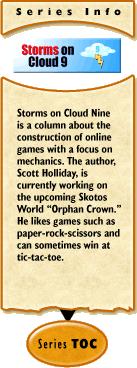 Storms on Cloud Nine #11:
Storms on Cloud Nine #11:
Population
by Scott Holliday
May 30, 2003
Watching trends in online games, it is becoming obvious that the bar of
success is changing. The first top-notch graphical games to hit the market
captured huge numbers of players and are still going strong. This causes a
problem for future releases in that many of the players are already
invested in one game or another. Though there are always new players
entering the market, the open customer base has become much smaller.
Furthermore, there are a hundred other online games about to release and
join the competition for their piece of the pie. In order to get a
population level equivalent to those first releases, you need to have some
hook. Most of the excitement today seems to be centered around games that
either explore a new genre or have established setting recognition.
Most developers that I see are reacting very quickly. Games are being
aimed at a smaller population base. What is the difference between a game
with a hundred players and a million? Although a million players can
possibly make for a deeper market system and large quest/war mechanics,
the advantage to a smaller player base is the close-knit community that
can be established. Every player can identify each of the other players by
name and sometimes even by appearance or behavior. On the other hand, a
larger game has more total income and is more likely to have paid staff
preparing patches, upgrades, and events.
In any case, speaking to the developers out there, you already probably
have some idea what size community to expect. The question then is whether
or not you are planning for it. Just this year, I saw a game released that
was bragging about how huge their world was. Checking the math, I see that
they were absolutely right. They have more than a million times the size
of any game world I've ever seen. Literally millions of huge locations and
hundreds of cities. Unfortunately, their total player base is less than
one thousand. Meaning player density is less than 0.01 per location. Even
in a city, chances are that you are the only player there at that time!
What is the point of an online game in which you almost never meet another
player? At best, you could arrange to get a small group together, but you
still have a very empty world.
If you know what size community to expect, game design should follow suit.
For an online game, there should be at least a little bumping of elbows.
On the other hand, if the game is too crowded, this is also bad. The best
way to plan for this is to figure out how many elbows you expect and make
sure you have the right amount of room for them all. In some ways, this is
simple, since you can plan certain high-use areas. A good example of this
would be the central safe-area in Grendel's Revenge. Players congregate
there, but if it gets too crowded, they still have room to spread out.
As far as more exact planning, my recommendation is to simply use
mathematics. Count the number of "areas" you have. For a text-based game,
this is simple. For a graphical game, you can divide your total area by
the distance that a character can see. This is a good basis to determine
your population density, although you must also realize that some areas
will be used more than others. In most games I've seen, shops and banks
are high traffic areas. If you have a thousand players who each spend 10%
of their time in a space station, you better have more than one station or
it's going to be crowded! Likewise, there will be low-traffic areas, such
as spots where players might go to have a private conversation. Obviously,
these areas should count less toward your total figure.
Perhaps the biggest question is what population density is desired. Do you
want 100 people in the space station at once? How many players do you want
at each asteroid? Assuming the number is fractional, what fraction? Always
remember that it is an online game. If there is so much room that your
chance of meeting someone out there is next to nil, you've defeated the
advantages of the media.

